Ageing and sexing details:
|
JAN - JUL: after-second-year
male |
Any American Redstart that is mostly black in spring can be immediately
recognized as an ASY male.

Photo by Marcel Gahbauer,
McGill Bird Observatory, May 2005
ASY males have blackish wings with extensive orange markings on the primaries and secondaries.

A typical ASY male wing.
Photo by Marcel Gahbauer,
McGill Bird Observatory, May 2005

On some males, such as this, the orange markings are somewhat paler.
Photo by Peter Pyle,
Braddock Bay Bird Observatory (NY), May 2010
ASY males have blackish tails with large orange patches on rectrices 3-6.

Photo by Marcel Gahbauer,
McGill Bird Observatory, May 2005
RETURN TO AGE/SEX
OVERVIEW
|
JAN - JUL: after-second-year
female |
ASY females are similar in overall appearance to SY females and also some SY males; distinguishing among these age/sex classes usually requires a good look at the wing and tail.
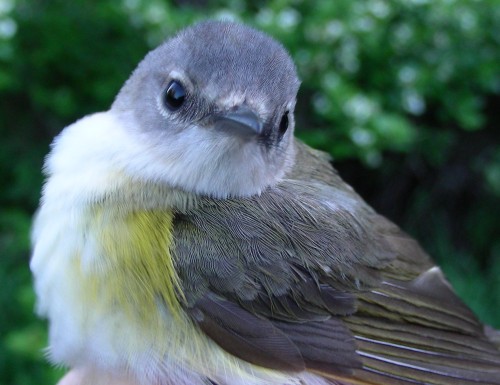
Photo by Marie-Anne Hudson,
McGill Bird Observatory (QC), May 2008
ASY females show no contrast between the greater coverts and primary coverts. The amount of yellow visible on the primaries and secondaries tends to be greater than on SY females, but is quite variable.

A typical ASY female wing with broad, dark primary coverts not contrasting at all
with the greater coverts.
Photo by Peter Pyle,
MerryLea (IN), May 2007

A somewhat paler wing, especially in terms of the reduced amount of yellow visible,
but note that the greater coverts and primary coverts are again uniform in colour.
Photo by Peter Pyle,
Braddock Bay Bird Observatory (NY), May 2010
ASY females have a relatively large amount of yellow on the tail, with at least some yellow on the inner web of r3.

A particularly yellow ASY female tail, with yellow across r3.
Photo by Peter Pyle,
MerryLea (IN), May 2007
RETURN TO AGE/SEX
OVERVIEW
|
JAN - JUL: second-year
male |
Most SY males can be easily recognized by the presence of some black feathers, most commonly in the lores, but sometimes also in the throat and upper breast. However, some SY males may lack any black plumage, and can appear quite similar to females. Most SY males also have orange rather than yellow patches on the side of the breast, but this colour can overlap with ASY females, therefore wing and tail need to be examined closely to identify such individuals..

A typical SY male, with black in the lores, and orange on the side of the breast.
Photo by Marcel Gahbauer,
McGill Bird Observatory, May 2005
On SY redstarts, there is a molt limit between the greater coverts and primary coverts, with the primary coverts slightly paler and relatively narrow and pointed. However, both the colour difference between feather tracts and the shape difference as compared to ASY redstarts are subtle.

A typical SY male wing, with only a very subtle contrast between the greater and primary coverts.
Photo by Peter Pyle, Braddock Bay Bird Observatory (NY), May 2010

Another SY male, with the greater coverts slightly greener and the primary
coverts slightly duller. Note that the extent of yellow on the primaries and
secondaries is comparable to that of many ASY females.
Photo by Marcel Gahbauer,
McGill Bird Observatory, May 2005
SY males have a tail quite similar to that of ASY females, with at least some yellow on the inner web of r3. Rectrix shape varies little by age in American Redstarts, and only SY individuals with unusually narrow and pointed rectrices can be recognized by shape.

A typical SY male tail, although the pattern on r3 is not clearly visible from this view.
Photo by Marcel Gahbauer,
McGill Bird Observatory, May 2005
RETURN TO AGE/SEX
OVERVIEW
|
JAN - JUL: second-year
female |
SY females are the palest age/sex class, similar overall to ASY females, but generally with a smaller and paler yellow patch on the side of the breast.
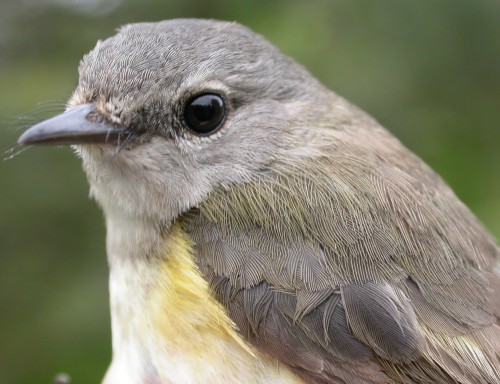
A typical SY female, dull gray, with only a small pale yellow patch on the side of the breast.
Photo by Marcel Gahbauer,
McGill Bird Observatory, May 2005
As is the case for SY males, SY females have a molt limit between the greater and primary coverts that is often rather subtle and difficult to detect with certainty. However, SY females can usually also be distinguished from others by having little or no yellow visible on the primaries and secondaries, and by it being very pale if present at all.

In this example, the primary coverts are only slightly paler than the greater coverts. One
of the central secondaries appears to have been adventitiously replaced, showing a typical
ASY female yellow pattern, in contrast with the much paler juvenile feathers on either side.
Photo by Peter Pyle, Braddock Bay Bird Observatory (NY), May 2010

A particularly dull SY female with no yellow at all visible on the primaries or secondaries.
Note that in this case the primary coverts are distinctly paler brown than the greater coverts.
Photo by Marcel Gahbauer,
McGill Bird Observatory, May 2005
SY females have only a limited amount of yellow on the inner web of r3; SY males and ASY females can also have a similarly limited pattern, but more commonly have yellow across the width of r3.

Photo by Marcel Gahbauer,
McGill Bird Observatory, May 2005
RETURN TO AGE/SEX
OVERVIEW
|
JUL - DEC: after-hatch-year
male |
Any
American Redstart in fall with extensive black plumage can be immediately
recognized as an AHY male.

An AHY male; note that a fair amount of the plumage is actually brown rather than black.
Photo by Simon Duval,
McGill Bird Observatory, August 2009

Photo by Marcel Gahbauer,
McGill Bird Observatory, August 2005
AHY males have blackish wings with extensive orange patches on the primaries and secondaries.

Photo by Simon Duval,
McGill Bird Observatory, August 2009

Photo by Marcel Gahbauer,
McGill Bird Observatory, September 2005
AHY males have have blackish tails with orange patches on r3-6.
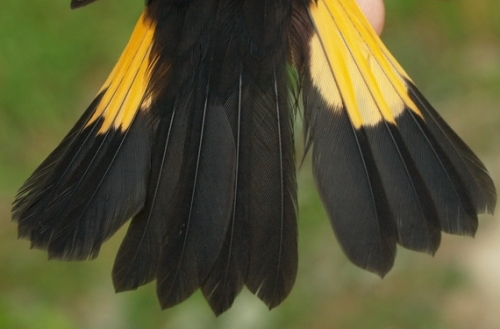
An AHY male with relatively little orange on the rectrices.
Photo by Simon Duval,
McGill Bird Observatory, August 2009

An AHY male with an extensive amount of orange, extending as far as the outer web of r2.
Photo by Marie-Anne Hudson,
McGill Bird Observatory, August 2007

Note in comparing the three photos above that the colour of the tail patches can vary from
pale orange through to salmon.
Photo by Marcel Gahbauer,
McGill Bird Observatory, August 2005
RETURN TO AGE/SEX
OVERVIEW
|
JUL - DEC: after-hatch-year
female |
AHY females and HY males are often quite similar in appearance, and checking for complete skull pneumatization is the best way to confirm AHY females in late summer and early fall.

A typical AHY female, with a moderately gray head, and a touch of orange to the breast patch.
Photo by Seabrooke Leckie,
McGill Bird Observatory, September 2006

Another example, with a breast patch near the dark limit of variation for AHY females.
Photo by Simon Duval,
McGill Bird Observatory, August 2010
AHY females lack molt limits on the wing and the primary coverts are broad and rounded; these distinctions may help separate them from HY males, but the differences tend to be subtle.

A typical AHY female wing, with distinctly broad and rounded primary coverts, no molt
limit between them and greater coverts, and a moderate amount of yellow showing on
the secondaries.
Photo by Seabrooke Leckie,
McGill Bird Observatory, September 2006
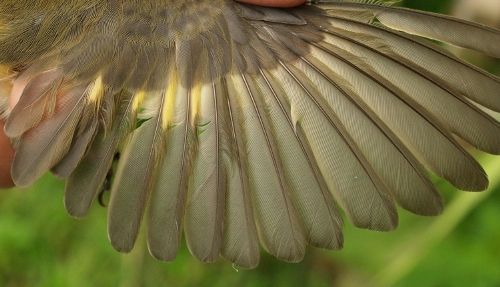
An AHY female in the late stages of prebasic molt, with two secondaries still growing in;
any American Redstart systematically replacing its flight feathers is an AHY. Note again
the lack of contrast between the greater and primary coverts.
Photo by Simon Duval,
McGill Bird Observatory, August 2010
The amount of yellow on r3 on AHY females can range from a small spot on the inner web to matching the full span of yellow seen on the outer rectrices. The full range of variation is similar to that of HY females, and the unmarked extreme overlaps with the pattern of HY females, so tail pattern alone is usually not helpful, although in combination with other features it may help confirm age and sex.

A relatively pale AHY female tail, with a limited amount of yellow on r3.
Photo by Marcel Gahbauer,
McGill Bird Observatory, August 2005

A typical AHY female tail with an intermediate amount of yellow on r3.
Photo by Seabrooke Leckie,
McGill Bird Observatory, September 2006
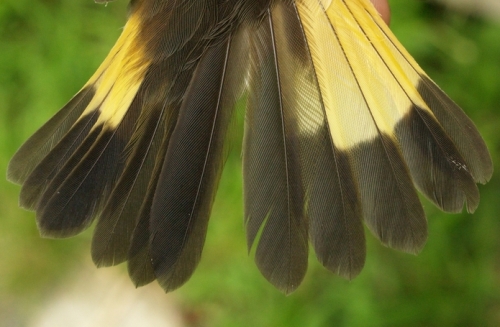
An example with yellow almost crossing over the entire inner web of r3, and with the
patches having a slight orange tinge to them.
Photo by Simon Duval,
McGill Bird Observatory, August 2010
RETURN TO AGE/SEX
OVERVIEW
|
JUL - DEC: hatch-year
male |
Some HY males can be easily recognized by already having black flecks in the lores or throat. A larger percentage of HY males can be recognized by having distinctly orange (rather than yellow) patches on the sides of the breast. However, there are others with more yellowish breast patches that are more difficult to separate from females, and a minority of individuals may have to be left as sex unknown. Males also tend to show more contrast between the head and back, and between the rump and back, but there are also some intermediates in this regard.

A relatively typical HY male with orange patches on the breast and a distinct contrast
between the head and back.
Photo by Marcel Gahbauer,
McGill Bird Observatory (QC), August 2008

An HY male with an unusually dark and extensive orange breast patch.
Photo by Simon Duval,
McGill Bird Observatory (QC), August 2010

An HY male at the other end of the spectrum, with a small breast patch that overlaps in
colour with AHY females; individuals like this require a good look at the wing and/or
skull to determine age with confidence.
Photo by Marcel Gahbauer,
McGill Bird Observatory, August 2005

An HY male with unusual pigmentation, the breast patch being similar to the salmon
colour of some AHY males, and much darker than the orange typical of HY males.
Photo by Seabrooke Leckie,
McGill Bird Observatory, August 2006

Another view of the same individual as above, showing some reddish tinges on the
back, which is usually greenish-gray, without any other colours.
Photo by Seabrooke Leckie,
McGill Bird Observatory, August 2006
HY redstarts have a molt limit between the greater and primary coverts, with the primary coverts somewhat paler, though the distinction tends to be subtle. The primary coverts are also somewhat narrower and more pointed than those of AHY redstarts, but this too is a minor difference. HY males usually have a moderate amount of yellow showing on the primaries and secondaries, within the same range of variation as AHY females, but generally quite a bit more than HY females.

A typical HY male wing, with the primary coverts slightly paler than the greater coverts,
and a moderate amount of yellow showing on the secondaries.
Photo by Marcel Gahbauer,
McGill Bird Observatory (QC), August 2008
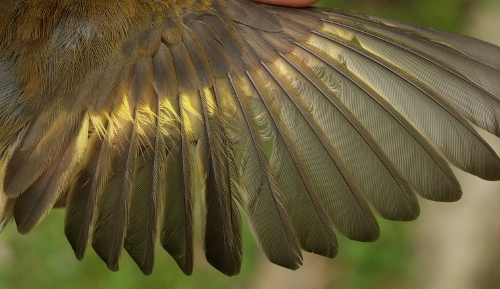
Another HY male, again with a subtle contrast between the greater and primary coverts.
Photo by Simon Duval,
McGill Bird Observatory (QC), August 2010
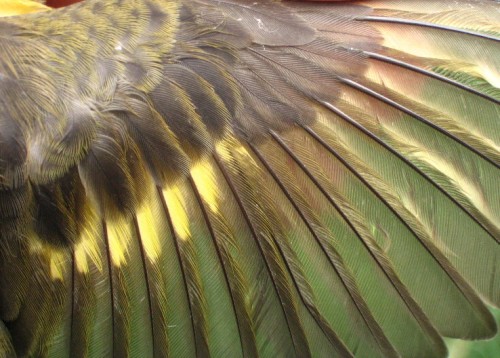
A closeup showing more clearly the difference between the darker fresh greater coverts
and the retained paler primary coverts; it also appear that the greater coverts have not
quite completed growing in this case, as they appear somewhat shorter than usual.
Photo by Seabrooke Leckie, McGill Bird Observatory, August 2006
HY males usually have at least some yellow on the inner web of r3 although there are occasional exceptions that fall into the pattern expected for HY females despite clearly being males by other criteria.
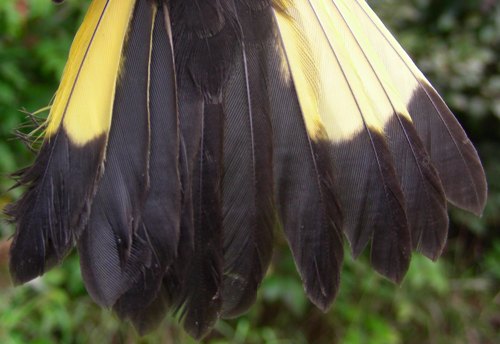
An HY male tail with only a small amount of yellow on the inner web of r3.
Photo by Marcel Gahbauer,
McGill Bird Observatory (QC), August 2008

Another HY male with barely any yellow on the inner web of r3, but note the orange tinge
to the yellow patches. Also, while rectrix shape is usually intermediate on American
Redstarts, this tail has juvenile rectrices that are distinctly narrow and pointed.
Photo by Simon Duval,
McGill Bird Observatory (QC), August 2010

An HY male with unusually extensive yellow on the tail, extending over to the outer
web of r2. Again, the rectrices are quite pointed, and in this case there are also
several dark growth bars across the tip of the tail.
Photo by Marcel Gahbauer,
McGill Bird Observatory, August 2007

This unusually salmon-coloured tail corresponds to the abnormally reddish HY male
shown in the previous section; note that despite the dark colouration, the extent of the
tail patches is quite limited, barely extending to the inner web of r3.
Photo by Seabrooke Leckie,
McGill Bird Observatory, August 2006
RETURN TO AGE/SEX
OVERVIEW
|
JUL - DEC: hatch-year
female |
HY females are generally the palest American Redstarts, and at least the extremes may be tentatively
identified just by their overall drab appearance, but wing and tail
characteristics should be consulted for confirmation. Unlike HY males, they tend to lack a sharply-defined contrast between the head and back, and between the rump and back. The yellow patch on the side of the breast is usually small and quite pale, without any orange. A minority of HY individuals may be sufficiently intermediate between typical female and male patterns that they cannot be reliably sexed.
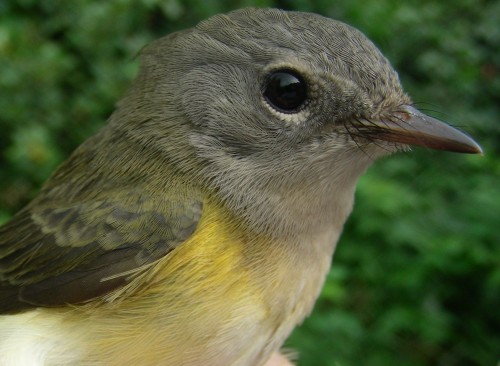
A typical HY female, with a small pale yellow patch on the side of the breast, and a
gradual transition from the gray of the head to the green of the back.
Photo by Marie-Anne Hudson,
McGill Bird Observatory, August 2007

Another HY female, slightly more gray on the head, but again pale on the breast.
Photo by Marcel Gahbauer,
McGill Bird Observatory, August 2007
HY females have a molt limit between the greater coverts and primary coverts but it tends to be even more subtle than on HY males. However, the HY female wing may still provide useful cues in that it usually has little if any yellow showing on the primaries and secondaries.

An HY female wing with yellow showing on just two of the secondaries, but with the
molt limit between the greater and primary coverts very indistinct.
Photo by Marcel Gahbauer,
McGill Bird Observatory, August 2007

Another HY female, with a bit more contrast between the greater and primary coverts,
though still subtle, and no yellow at all on the primaries or secondaries.
Photo by Marcel Gahbauer,
McGill Bird Observatory, August 2007
HY females have the least amount of yellow on the tail, with the pattern on r3 usually limited to the outer web, but occasionally extending to a small spot on the inner web.

A typical HY female tail, with the yellow on r3 limited to the outer web.
Photo by Marcel Gahbauer,
McGill Bird Observatory (QC), September 2009

Another HY female tail with a similar pattern, but a bit paler overall.
Photo by Marcel Gahbauer,
McGill Bird Observatory, August 2005
RETURN TO AGE/SEX
OVERVIEW








































































